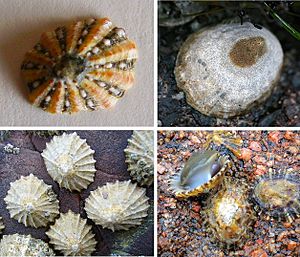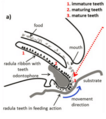Limpet facts for kids
Quick facts for kids Limpets |
|
|---|---|
 |
|
| Scientific classification | |
| Kingdom: | |
| Phylum: | |
| Class: | |
| Order: |
Patellogastropoda
Lindberg, 1986
|
A limpet is a type of sea snail, which is a gastropod (a kind of mollusc). Limpets have a simple, cone-shaped shell. The term "true limpets" refers to a specific group of marine limpets called Patellogastropoda. This article mainly talks about these true limpets.
True limpets are small sea snails with flat, cone-shaped shells. They live in the intertidal zone, which is the area along the coast that is covered by water at high tide and exposed to air at low tide. They stick to rocks or other hard surfaces using a strong, muscular "foot" and a sticky substance called mucus. This helps them stay attached, protecting them from drying out when the tide is low and from strong waves.
Contents
What Limpets Eat
Limpets eat by scraping algae (tiny plant-like organisms) off rocks. They use a special ribbon-like tongue called a radula, which has many rows of strong teeth. They move slowly by rippling the muscles in their foot. Most limpets are less than 3 inches (8 centimeters) long. However, some, like the West Mexican Limpet, can grow up to 8 inches (20 centimeters)!
Some limpets, called key-hole limpets, have a small hole at the top of their shell. This hole helps them breathe. But remember, key-hole limpets are not considered "true limpets."
Limpets Through Time
Limpets have been around for a very long time! Scientists have found many limpet fossils from the Paleozoic era, which was hundreds of millions of years ago. The earliest true limpet fossil that scientists are sure about comes from Italy, dating back to the Triassic period. Many of the limpet types we see today first appeared much later, during the Upper Cretaceous and Cainozoic periods.
Limpet Life Style
Limpets are mostly sessile, meaning they stay stuck to rocks or other hard surfaces.
Homing Behavior
Some limpet species have a special "home scar" on the rock. This is a spot where their shell fits perfectly. They return to this exact spot before the tide goes out. Scientists think they follow a trail of mucus (a slimy substance) they leave behind as they move. By fitting perfectly into their home scar, they can seal themselves tightly against the rock. This helps them avoid drying out when the tide is low.
Some limpets, like Lottia gigantea, even "garden" their own patch of algae around their home. They push away other creatures from this area, making sure there's plenty of algae for them to eat.
Predators and Defenses
Limpets have several enemies, including starfish, shore-birds, fish, seals, and even humans. When a predator comes near, limpets have two main ways to defend themselves:
- They can let go of the rock and float away in the water.
- They can clamp their shells down very tightly against the surface.
Limpets can sense what kind of predator is nearby by detecting chemicals in the water. This helps them choose the best defense.
Limpets can live for a long time. Some have been known to live for over 10 years! If a limpet lives on a bare rock, it might grow slower but can live for up to 20 years.
Limpets that live on sheltered shores (where there are fewer waves) are more likely to dry out because of the sun, wind, and water evaporation. To prevent this, they clamp tightly to the rock, which helps them keep water inside their shell.
Reproduction and Life Cycle
Limpets are hermaphrodites, meaning they can produce both male and female reproductive cells. They also change sex during their lives! They start out as males when they are about 9 months old. After a couple of years, they change and become females.
Limpets usually reproduce once a year, often in winter. Rough seas help spread their eggs and sperm. The baby limpets, called larvae, float in the ocean for a few weeks. Then, they settle down onto a hard surface, like a rock, and start to grow into adult limpets.
Images for kids
-
A true limpet, Patella vulgata, on a rock in Wales.






